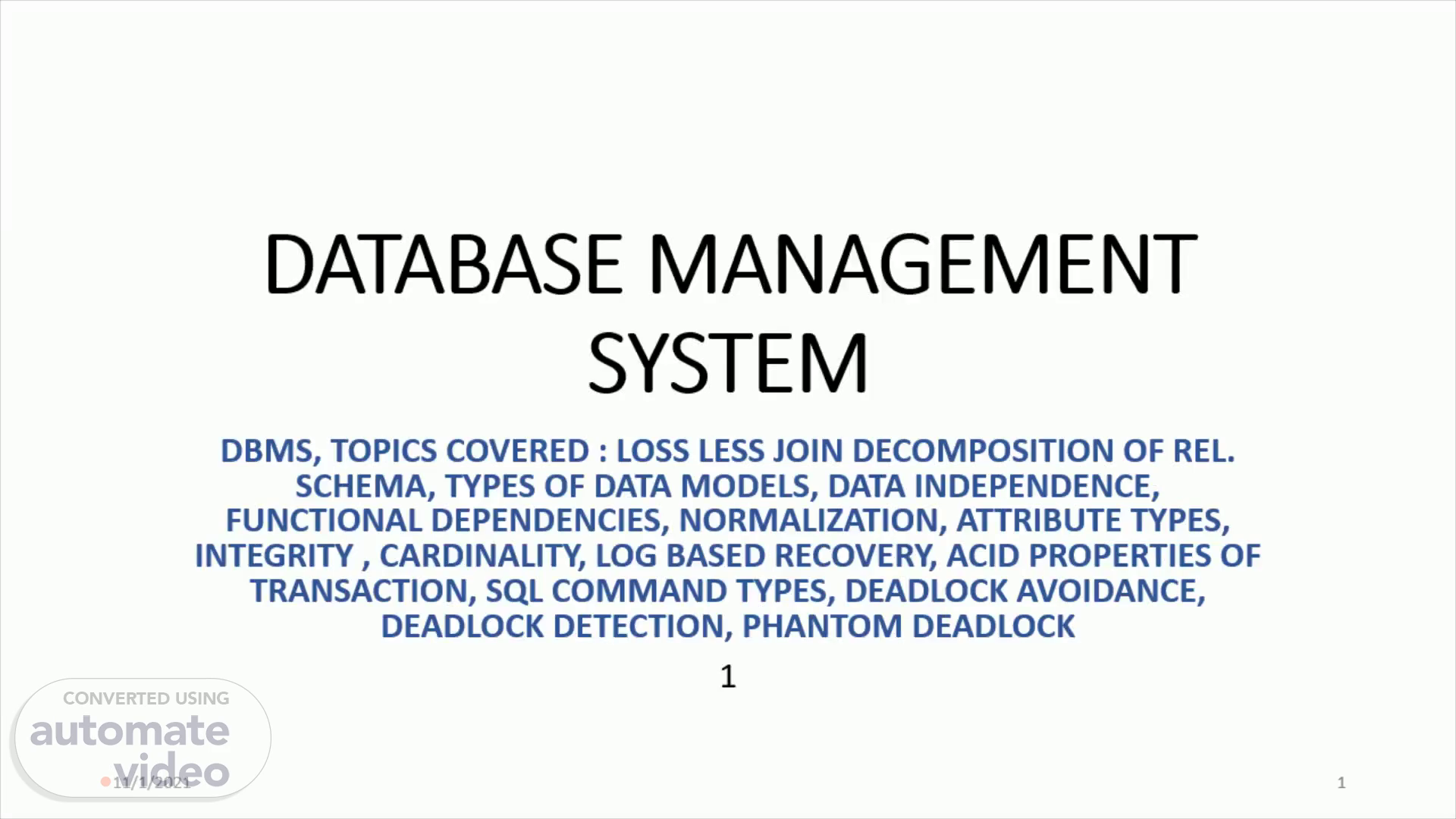
DATABASE MANAGEMENT SYSTEM
Scene 1 (0s)
DATABASE MANAGEMENT SYSTEM. DBMS, TOPICS COVERED : LOSS LESS JOIN DECOMPOSITION OF REL. SCHEMA, TYPES OF DATA MODELS, DATA INDEPENDENCE, FUNCTIONAL DEPENDENCIES, NORMALIZATION, ATTRIBUTE TYPES, INTEGRITY , CARDINALITY, LOG BASED RECOVERY, ACID PROPERTIES OF TRANSACTION, SQL COMMAND TYPES, DEADLOCK AVOIDANCE, DEADLOCK DETECTION, PHANTOM DEADLOCK 1.
Scene 2 (19s)
10/29/2021. 2. DBMS. A database is organized repository of data and processed data or information stored in a centralized data server ,provides removal of data redundancy through normalization, provides multiple views of data and multiple user access to data ..
Scene 3 (33s)
10/29/2021. 3. DBMS. Loss less join decomposition of rel. schema : what is schema ? The overall design of database is schema and collection of information stored at a particular instant is instance . Schema of database are changed very rarely and if at all by DBA only . We have 2 rels . R1 and R2 s.t for all attributes in R1 and R2 we have R1 U R2 -- R1 and R1 U R2- R2 . Dependency preservation occurs herein.
Scene 4 (54s)
10/29/2021. 4. DBMS. Object based Entity Relationship data model Object oriented data model Sementic Functional data model Data Model Record based Relational Network data model Hierarchical data model Physical Unifying data model Frame memory data model.
Scene 5 (1m 3s)
10/29/2021. 5. DBMS. What is Data Independence of DBMS? Data Independence is defined as a property of DBMS that helps you to change the Database schema at one level of a database system without requiring to change the schema at the next higher level. Data independence helps you to keep data separated from all programs that make use of it. You can use this stored data for computing and presentation. In many systems, data independence is an essential function for components of the system. Physical Data Independence Physical data independence helps you to separate conceptual levels from the internal/physical levels. It allows you to provide a logical description of the database without the need to specify physical structures. Compared to Logical Independence, it is easy to achieve physical data independence . Logical Data Independence Logical Data Independence is the ability to change the conceptual scheme without changing External views External API or programs Any change made will be absorbed by the mapping between external and conceptual levels. When compared to Physical Data independence, it is challenging to achieve logical data independence..
Scene 6 (1m 47s)
10/29/2021. 6. DBMS. TYPES OF FUNCTIONAL DEPENDENCIES.
Scene 7 (2m 8s)
10/29/2021. 7. DBMS. NORMALIZATION : the removal of data redundancy from tables/ rels . Is normalization While 1NF has redundant data Removed to some extent in 2NF Still higher normal form is BCNF ; defines super key values. All rels . On 3NF are in BCNF but reverse is not always true 3NF describes candidate key values , transitive dependencies 4NF defines multi valued dependencies 5NF describes join dependencies.
Scene 8 (2m 28s)
10/29/2021. 8. DBMS. Types of Attributes | DBMS | Gate Vidyalay.
Scene 9 (2m 36s)
10/29/2021. 9. DBMS. Cardinality Database EMPLOYEE WORKS_ON PROJECT.
Scene 10 (2m 42s)
10/29/2021. 10. DBMS. LOG BASED RECOVERY DEFFERED DATABASE MODIFICATION.
Scene 11 (2m 50s)
10/29/2021. 11. DBMS. ACID Properties in DBMS The entire transaction takes place at once A = Atomicity or doesn't happen at all. The database must be consistent before C = Consistency and after the transaction. ACID Multiple Transactions occur independently I = Isolation without interference. The changes of a successful transaction D = Durability occurs even if the system failure occurs..
Scene 12 (3m 5s)
10/29/2021. 12. DBMS.
Scene 13 (3m 11s)
10/29/2021. 13. DBMS. In a database, a deadlock is an unwanted situation in which two or more transactions are waiting indefinitely for one another to give up locks . Deadlock is said to be one of the most feared complications in DBMS as it brings the whole system to a Halt Deadlock Detection – When a transaction waits indefinitely to obtain a lock, The database management system should detect whether the transaction is involved in a deadlock or not. Wait-for-graph is one of the methods for detecting the deadlock situation. This method is suitable for smaller databases. In this method, a graph is drawn based on the transaction and their lock on the resource. If the graph created has a closed-loop or a cycle, then there is a deadlock. For the above-mentioned scenario, the Wait-For graph is drawn.
Scene 14 (4m 16s)
10/29/2021. 14. DBMS. Phantom Deadlock is a deadlock that occurs in a Distributed DBMS due to communication delays between different processes and leads to unnecessary process abortions . In fact, it is not really a deadlock. ... The Distributed DBMS can use any deadlock detection algorithm to detect the deadlock..